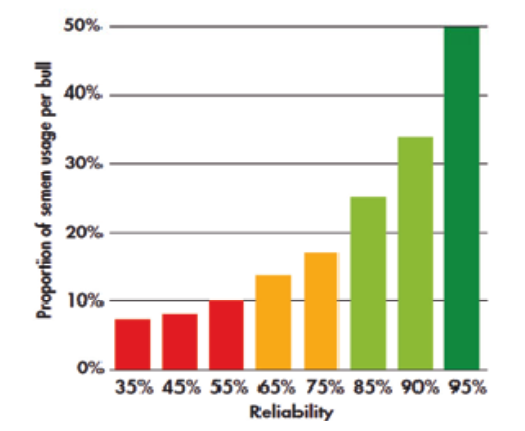The following guide is designed to help understand and utilise genomic evaluations.
KEY ASPECTS OF GENOMIC EVALUATIONS:
- Young bulls can be genotyped as soon as they are born
- Genomic evaluations of young bulls, which have no daughters included in their evaluation, are calculated via a combination of pedigree and genomic information.
- Young bulls with only pedigree information and no genomic test cannot have a reliability greater than 0.49 (or 49%), and will typically achieve around 35%.
- Genomically tested young bulls, which have no daughter information, cannot have a reliability over 80% with the current technology. Young bulls typically achieve 60 to 70% reliability with genomic testing, which is the equivalent (in terms of genetic information) to a bull with 10 milking daughters.
- The reliability value describes the amount of a bulls' genetic merit which has been estimated with the genomic and pedigree information. I.e. a bull with 65% reliability has 35% of its genetic merit not explained in the evaluation.
- The lower the reliability of the trait or index, the greater the chance of change in the trait or index, as more information is added.
- As daughter information becomes available, this will be included in the genetic evaluation of the bull, and the reliability of the bulls' data will increase.
- As more daughter information becomes available, genomic information will contribute less to the bulls' genetic indices.
- Prior to genomic selection, bulls were progeny tested and their semen was not marketed until the bull was around 6 years of age, with an index reliability of approximately 85%.
- Therefore genomic young bulls typically have 15 to 20 % less information about their genetic merit, included in their evaluations, as compared to first proof 'proven bulls' historically.
- As genomic tested sires are first used at an early age (around 15 months or less), and continue to be used as they age, they will achieve high reliability (90% and over) proofs much sooner (4 to 5 years of age for heavily used sires) than in the proven bull era.
- Progeny 'testing' still takes place, with Cogent and Genus actively formally testing sires in the UK.
NB
Most AI bulls now have some genomic component to their evaluation.
- The terms 'proof' or 'proven' are used in the dairy cattle breeding industry to indicate bulls which have daughter information included in their genetic evaluation.
- Bulls described as 'young genomic sires' will not have daughter information included in their genetic evaluation.
WHAT BULL LISTS ARE PUBLISHED IN THE UK?
Holstein UK and AHDB Dairy publish two categories of lists for Holstein bulls. The first type (with proven in the list name) will feature bulls with milking daughters contributing to their index and the second (with genomic in the name) will feature young genomic bulls with no milking daughters. Only bulls with a reliability of at least 65% (and 10 milking daughters for production) will feature in the first list while bulls whose indices have reliabilities of more than 40% will feature in the young sire list.
WHAT PROPORTION OF YOUNG GENOMIC BULLS SHOULD BE USED IN A HERD?
There are no hard-and-fast rules governing the use of genomic bulls, although any low reliability bull should be used with caution. Their use should be partly governed by the farmer’s attitude to risk and some may prefer to have the security of using only high reliability bulls with plenty of daughter information. However, in this case, the farmer could be missing out on potential genetic gain that could come from using younger bulls with higher genetic merit for e.g. Type traits and/or PLI. Across a whole herd, it is generally recommended that a mix of proven and young genomic bulls is used to obtain a balance between risk and reward, but the precise amount of each comes down to personal preference.
The graph gives DairyCo recommended levels of usage of semen from individual bulls at different levels of reliability. In practice, it is recommended that only 7% of a herd should be bred to a young sire with no genomic information; up to 12.5% could be bred to a genomic tested young bull; around 25% can be bred to a first crop daughter-proven bull (80 to 90% rel.) and 50% of a herd can be bred to a bull with a highly reliable index.
However, it is always important to remember that the younger generation does not necessarily give greater genetic gain. Young sires should only be considered for use if they have greater genetic merit than proven sires.

FEMALE GENOMIC EVALUATIONS
Genomic testing of females, offers the ability to greatly increase the understanding of genetic merit at a young age. This is especially useful as most cows will never gain substantial reliability in their lifetimes. Only cows with a large number of (usually ET bred) progeny will reach even 75% reliability in conventional genetic evaluations. Therefore, genomic tested heifers can attain the same reliability as most older cows with offspring and typically almost twice that achieved with parent index only.
WHICH FEMALES TO TEST?
Heifers will typically have the highest genetic merit within a herd, as better and better sires are used each year. Genomic testing should be used to identify those heifers with the highest genetic merit. This will allow the breeder to make more accurate decisions regarding which animals to keep as replacements for the milking herd, as well as identifying outstanding individuals for particular attention in breeding programs. The genomic tests offered through Holstein UK and CIS (powered by NBDC) is available for pedigree Holsteins, Friesians, Jerseys and Ayrshires.
Older cows can be tested, but remember that these will usually be of inferior genetic merit to younger animals in the herd.
UK Genomic indexes (including gPLI and Type Merit) can be obtained for female Holsteins, through Holstein UK.
UK genomic indexes for pedigree Holsteins and Friesians are displayed on the Holstein UK website.
STOCKBULLS
Bulls intended for use as natural mating sires can also be genotyped via genomic testing. As with young AI sires and females, this will also provide more accurate information which can be used in making breeding decisions. Remember, that with increasing uptake of genomic testing, breeders will more commonly have genomic test information available for young bulls (such as those which have not made the cut for AI) and are intend for sale as potential Stockbulls. Bulls need to be tested before they are 15 months of age to qualify for unofficial genomic results, which are accessible the owner but are not be eligible for publishing.
IF YOU HAVE ANY QUESTIONS REGARDING GENOMIC TESTING THROUGH HOLSTEIN UK PLEASE CONTACT:

- NBDC
- Scope House
- Hortonwood 33
- Telford
- Shropshire
- TF1 7EX
General Enquiries
+44 (0) 1923 695202